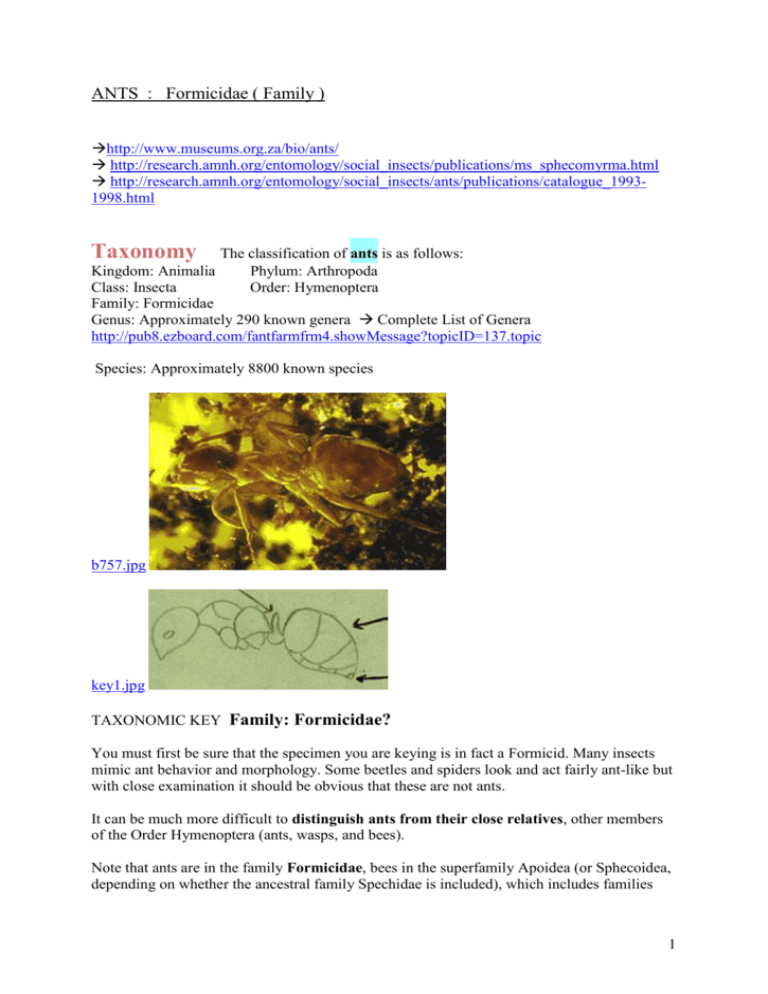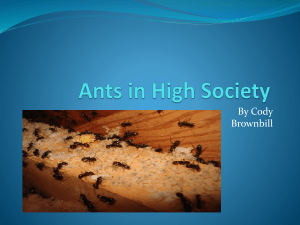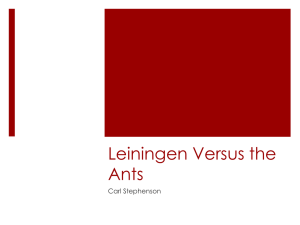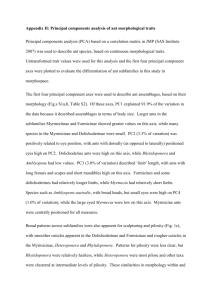ANTS : Formicidae ( Family )
advertisement

ANTS : Formicidae ( Family ) http://www.museums.org.za/bio/ants/ http://research.amnh.org/entomology/social_insects/publications/ms_sphecomyrma.html http://research.amnh.org/entomology/social_insects/ants/publications/catalogue_19931998.html Taxonomy The classification of ants is as follows: Kingdom: Animalia Phylum: Arthropoda Class: Insecta Order: Hymenoptera Family: Formicidae Genus: Approximately 290 known genera Complete List of Genera http://pub8.ezboard.com/fantfarmfrm4.showMessage?topicID=137.topic Species: Approximately 8800 known species b757.jpg key1.jpg TAXONOMIC KEY Family: Formicidae? You must first be sure that the specimen you are keying is in fact a Formicid. Many insects mimic ant behavior and morphology. Some beetles and spiders look and act fairly ant-like but with close examination it should be obvious that these are not ants. It can be much more difficult to distinguish ants from their close relatives, other members of the Order Hymenoptera (ants, wasps, and bees). Note that ants are in the family Formicidae, bees in the superfamily Apoidea (or Sphecoidea, depending on whether the ancestral family Spechidae is included), which includes families 1 such as the Apidae, Halictidae, etc., and wasps are every other Hymenopteran family (such as Vespidae, Ichneumonidae, and many others). Several wasp families with wingless females, especially the velvet ants (Mutillidae), the Bethylidae, and the Tiphiidae look very much like ants. Some wingless ichneumonids (Ichneumonidae) even look ant-like. Confounding matters even more, most reproductive ants are winged, at least until they mate, and may look rather wasp-like. Which of these Hymenopterans are ants? These specimens are (from left to right, top to bottom): an interesting ant-like Hymenopteran which may be a Tiphiid, a male velvet ant, an ant (a winged male Ponera pennsylvanica), a female velvet ant, an ant (a winged male Formica obscuripes), and an ichneumonid. Ants are distinguished from these ant-like groups by a few morphological characters: ants have 6-13 antennal segments, the first (=scape) of which is lengthened to cause a characteristic bent antenna (note though that some male ants, such as the Ponera pictured above does not have lengthened scapes and bent antenna), and most importantly, a humplike node at the petiole, the segment at the junction between the thorax and abdomen (Bolton 1994 and Gauld and Bolton 1988). These characters are often not obvious and it may be difficult at first to be sure the Hymenopteran is in fact a member of the family Formicidae. After a while though, it is usally possible to recognize ants by their gestalt. Morphology Ants have three major body parts: head, thorax, and gastor (abdomen). The thorax can be broken down into two major parts: the alitrunk which contains the legs and wings, and the petiole which is found directly anterior to the gastor and is found only in ants. Ants have mandibles (jaws) which are of varied structures. These varied structures provide for a plethora of functions ranging from grasping, tearing, cutting and other special tasks. Most ants have a stinger at the end of the gastor. Some ants can release this stinger in a similar fashion to honeybees. The stinger is only found in female ants and is a modified ovipositor (egg laying organ). Ants have compound eyes which have not been shown to effect 2 their behavior, although some ants seem to be able to detect movement. They have very sensitive antennae that are used for a wide array of communication. Nearly all ants have a unique gland found on the petiole called the metapleural gland. Most importantly, this gland has been shown to contain antibacterial and antifungal chemicals which are essential for survival in the humid, dark nests in the ground or rotting vegetation. This gland secretes an antiseptic substance that at times acts as a repellent to attacking organisms. It is also thought that the metapleural gland releases pheromones for communication. Origins The oldest fossil remains of modern ants is preserved in amber and has been dated by radioactive isotopes to be approximately 80 million years old. It has many of the characteristics of modern ants while also presenting many characteristics of the ant's distant relative, the nonsocial aculeate wasp. Like modern ants, the fossil contains the metapleural gland, petiole turning down towards the gastor, and a relatively small thorax without wings. The fossil contains the following wasp like characteristics: short mandibles with only two teeth, stinger that can be extruded, unconstricted gastor, and double tibial spurs. The fossil antennae have a short first segment and a long flexible segmented structure for the rest of the antennae. This antennae combines both wasp and ant features. An early Cretaceous fossil that may be an ant has been discovered. Unfortunately, the gastor has been folded back over the thorax, thereby restricting the view of the petiole. It is a less well preserved specimen, and, therefore, scientists are uncertain as to its' morphology. Ants evolved from wasp-like ancestors. Evolutionists, claim that ants evolved 80 million years ago from "Tiphiidae",( Tiphiidae a family of small, black hairy wasps, hymenopteran insects belonging to the superfamily Scolioidea; the larvae are ectoparasites of beetle larvae and some are used in biological control of pests. ) which is an archaic genus of wasps, and that they started socializing 40 million years ago – suddenly, "at their own discretion" - and that they constitute the highest level of the evolution of insects. 3 The earliest ant-like fossils have been dated to c 110 million years ago in the Cretaceous and the first definite ant fossils are from 90 million years ago. The main diversification occurred 40-50 million years ago in the Tertiary http://www.formica.de/stammesgeschichte/stammesgeschichte-r.htm Beschriebene Art Fundort Fossilart Kaste Ameisenmerkmale Klassifikation Arbeiterin + Männchen siehe oben In neueren Funden Nachweis der Metapleuraldrüse; Formicidae, Sphecomyrminae Formicidae, Sphecomyrminae Sphecomyrma freyi < New Jersey Bernstein 8090 Mio. Jahre Cretomyrma arnoldii Sibirien Bernstein 80 Mio. Jahre Arbeiterin Petiolus, Metapleuraldrüse vorhanden, zusätzliche Zähne an der Spitze der Mandibeln Cretomyrma unicornis Sibirien Bernstein 80 Mio. Jahre Arbeiterin Petiolus, Metapleuraldrüse vorhanden Formicidae, Sphecomyrminae Dlusskyidris zherichini Sibirien Bernstein Männchen keine Metapleuraldrüse erkennbar Formicidae, Sphecomyrminae Petropone petiolata Kazachstan Versteinerung 90 Mio. Jahre Arbeiterin (klik) Cretopone magna Kazachstan Versteinerung 90 Mio. Jahre Archaeopone kzylzharica Kazachstan Versteinerung Dolichomyrma longiceps Kazachstan Versteinerung Armania robusta Russland Pseudoarmania rasnitsyni Pseudoarmania araberrans Ponerinae? Genus incertae sedis Formicoidae Wahrscheinlich nicht zu den Aculeata (Bienen, Wespen, Ameisen) gehörig Petiolus (ohne Knoten) Genus incertae sedis Formicoidae Arbeiterin ? Petiolus Genus incertae sedis Fomicidae Versteinerung 100 Mio. Jahre Königin Großer Petiolus Armaniinae ? Russland Versteinerung 100 Mio. Jahre Königin Petiolus Russland Versteinerung Petiolus 4 Armaniella curiosa Russland Versteinerung Königin Petiolus Archaeopone taylori Russland Versteinerung Männchen Petiolus Poneropterus sphecoides Russland Versteinerung Männchen Petiolus Formicidae, Sphecomyrminae Formicidae, Sphecomyrminae Sphecomyrma canadensis Alberta, Kanada Bernstein 78 Mio. Jahre Arbeiterin + Männchen wie S. freyi, aber Körper insgesamt kräftiger gebaut, 3. Antennensegment wie 2. Antennensegment, bei S. freyi ist 3. Antennensegment mehr als doppelt so lang wie das 2. Sphecomyrma sp. Alberta, Kanada Bernstein Arbeiterin wie S. freyi aber andere Antennen- und Mandibelmorphologie Cretacoformica explicata Victoria, Australien Versteinerung 115 Mio. Jahre Baikuris mandibularis Sibirien Bernstein 80 Mio. Jahre Baikuris mirabilis Sibirien Bernstein 80 Mio. Jahre Cariridris bipetiolata Brasilien Versteinerung 110 Mio. Jahre Brownimecia clavata USA, white oak site Bernstein, Alter wie Sphecomyrma Wahrscheinlich nicht zu Apocrita gehörig Männchen keine Metapleuraldrüse erkennbar, Mandibeln ohne Zähne, abgetrennter Petiolus mit Knoten Formicidae, Sphecomyrminae Männchen keine Metapleuraldrüse erkennbar, Mandibeln ohne Zähne, abgetrennter Petiolus mit Knoten Baikuris zeigt jedoch auch gewisse Ähnlichkeiten zu Männchen von Amblyopone, der primitivsten rezenten Ponerine auf (Mandibeln, Einschnürung zwischen 1. und 2. Gastersegment) Formicidae, Sphecomyrminae Arbeiterin Petiolus recht lang, der ameisentypische Fühlerschaft (Scapus) scheint sogar länger zu sein als bei Sphecomyrma (der kurze Schaft hat hier schon öfter zu der Vermutung Anlaß gegeben, es handele sich bei Sphecomyrma nicht um eine Ameise). Postpetiolus möglicherweise Artefakt. Kalkstein verdeckt noch wichtige Details des Fossils (Mandibularzähne und Metapleuraldrüse nicht erkennbar, daher nicht sicher Ameise) Formicidae, Myrmiciinae Arbeiterin Fühlerschaft halbe Länge der Fühlergeisel (bei Sphecomyrma freyi ein Viertel), Mandibeln lang und Formicidae, Ponerinae 5 dünn, ohne Zähne. Hinterleib signifikant zwischen erstem und zweitem Segment eingeschnürt. Vor allem die Antennenform unterscheidet die Art von allen anderen Ameisen aus Bernstein der Kreidezeit. Es handelt sich bei Brownimecia wahrscheinlich um eine echte primitive Ponerinae; primitiv selbst gegenüber der primitisten lebenden Ponerinae Amblyopone Haidomyrmex Dlussky Cariridris bipetiolata Burma Bernstein, späte Kreidezeit oder Tertiär Formicidae, Myrmiciinae Arbeiterin Bizarre Art, Alter des Bernsteins nicht genau bestimmbar, möglicherweise eine Schnappfallenkieferameise wie Acanthognathus aufgrund der Mandibelform und der Sinneshaare am Rand des Clypeus. Der Fühlerschaft ist sehr kurz, deutlich kürzer als bei den Sphecomyrminae. Sicher nicht mit Brownimecia verwandt. Auf jaden Fall Ameise, aber möglicherweise aus dem Tertiär und nicht aus der Kreidezeit. Versteinerung 110 Mio. Jahre Formicidae, Sphecomyrminae ? Brasil / arbeidster cariridrisbipetiolata.jpg 6 Trotz sehr guter Erhaltung läßt die Versteinerung keine endgültige Aussage zu Petiolus recht lang, der ameisentypische Fühlerschaft (Scapus) scheint sogar länger zu sein als bei Sphecomyrma (der kurze Schaft hat hier schon öfter zu der Vermutung Anlaß gegeben, es handele sich bei Sphecomyrma nicht um eine Ameise). Postpetiolus möglicherweise Artefakt. Kalkstein verdeckt noch wichtige Details des Fossils (Mandibularzähne und Metapleuraldrüse nicht erkennbar, daher nicht sicher Ameise ) . Un spécimen unique a récemment été découvert par des paléontologues brésiliens dans des dépôts rocheux crétacés près de Santana do Cariri, à l’est du pays dans l’Etat de Ceara. Le spécimen, d’âge compris entre 100 et 112 millions d’années, n’est pas une Sphecomyrma, ressemblant bien plus aux primitives fourmis bouledogue qui vivent actuellement en Australie. Décrite en 1991 par C. Roberto Brandão, ancien étudiant du laboratoire de Hölldobler et Wilson, cette fourmi reçut le nom de Cariridris bipetiolata. In 1966 the missing link of ant evolution, the Ur-ant that joins the modern forms to their ancestors among the wasps, was finally discovered...Prior to this find, there had been mostly frustration. The known fossil record had stopped cold in Eocene sediments some 40 to 60 million years old; earlier rocks and amber pieces seemed to offer no clues. 7 The few specimens from the earliest, Eocene, record at the disposal of myrmecologists were poorly preserved but clearly belonged to modern groups. They were not much different in anatomy from living forms and offered no clues as to how ants came into existanc Creationists had taken note of this absence in their campaign to discredit the theory of evolution. Ants, they argued, are an example of a group put on earth by a single act of special creation. Those of us reconstructing the evolutionary history of ants believed otherwise. We guessed that the earliest species were simply very scarce, and that the fossil beds containing them were just poorly explored, so that in time at least a few specimens would turn up. We believed that the missing link existed in deposits of early Eocene age, perhaps 60 million years old, or further back still, into the Mesozoic Era. The Ur-ant may well have stung an occassional dinosaur. The Ur-ant was discovered by Mr. and Mrs. Edmund Frey...[they] sent an amber piece containing two worker ants to Donald Baird of Princeton University. Baird, recognizing its scientific importance, passed it on to Frank M. Carpenter of Harvard University, the world authority on insect paleontology and teacher of Edward Wilson. Carpenter called Wilson on the telephone, two floors above him in Harvard's Biological Laboratories. "The ants are here," said Carpenter. "I'll be down in two milliseconds," Wilson replied, adrenalin surging. Wilson ran down the stairs and into Carpenter's office, picked up the specimen, fumbled with it and dropped it on the floor, whereupon it broke into two pieces. Fortunately, each fragment contained an ant still in place and undamaged. Both pieces were composed of clear, pale, golden matrix. When polished they provided beautiful views of the ants, wonderfully preserved, as though the insects had been entombed only the day before. The amber was the fossilized resin of sequoia trees that grew at the Cliffwood Beach locality 90 million years agao, near the middle of the Cretaceous Period, when dinosaurs were still the dominant large land vertebrates. Wilson put the fossils under the microscope and began to sketch and measure them from all sides. After several hours he picked up the telephone and called William L. Brown at Cornell University. Brown was a fellow specialist in ant classification who had for years shared his dream of finding a Mesozoic ant and thereby, perhaps, to learn the identity of the missing link to the ancestral wasps. Both men had guessed from comparisons to living species what traits the ancestral form might, or, if evolutionary theory is correct, SHOULD possess. Wilson reported that the ants were indeed as primitive as expected. They had a mosaic of anatomical features found 8 variously in modern ants or in wasps as well as some that were intermediate between the two groups. The diagnosis of the Ur-ant was astounding: short jaws with only two teeth, like those of wasps; what appears to be the blisterlike cover of a metapleural gland the scretory organ (located at the thorax, or mid-part of the body) that defines modern ants but is unknown in wasps; the first segment of the antennae elongated to give them the elbowed look characterizing ants, yet here, in the Mesozoic fossils, only to a degree intermediate between modern ants and wasps; the remaining, outer part of the antennae long and flexible, as in wasps; the thorax with a distinct scutum and scutellum (two plates forming the middle part of the body); also a trait of wasps; and an antlike waist; yet one that is simple in form, as though it had only recently evolved. We gave them the formal name Sphecomyrma Freyi. The generic name Sphecomyrma means "wasp ant" and Freyi honors the couple who found [them]." I would suggest that this is a multi-faceted prediction: 1. that an ant-wasp intermediate would exist at all. 2. the attributes it would possess. 3. the strata in which it would be found. I think this fits the bill: a bold prediction based on a theory, directly contested by those opposing the theory, stunningly confirmed by a discovery. If you want confirmation that ants were regarded as a product of special creation, ask Arthur Biele. He maintained that very position on this newsgroup only last year, unaware that the battle had been lost thirty years before. Here were his words: “ ….. An evolutionist, believes that the first ant species evolved from something that was not quite an ant, and that all ant species alive today have descended from this original ant type. As a creationist, I believe that the first ant type (ant baramin) was created fully functional to be an ant and contained the information, via intelligent design, that produced the many species of ant alive today... It appears abruptly in the geologic record, with no history of evolution transition from some non-ant. The ant is found in the fossil record as a completely functioning `ant', and has remained unchanged in the 50 million years since it first appeared in the fossil record. ….. “ Ants date back 92-millions http://research.amnh.org/entomology/social_insects/publications/ms_sphecomyr ma.html A formicine in New Jersey Cretaceous amber (Hymenoptera: Formicidae) and early evolution of the ants 240452097v1.pdf 9 New and Rediscovered Primitive Ants (Hymenoptera: Formicidae in Cretaceous Amber from New Jersey, and Their Phylogenetic Relationships Primitive.doc A team of researchers from the American Museum of Natural History announced recently the discovery of the oldest fossil ants ever found. The extremely rare 92-million-year-old ants are preserved in amber from a location in New Jersey. The new specimens are 50 million years older than the most ancient fossils that were previously clearly recognized as ants; the find thus proves the existence of ants back into the Age of the Dinosaurs. The new specimens have important implications for understanding both the origin of ants and their rise to a position of ecological dominance in the world today. The new ant specimens are of particular consequence because they show the presence of a "metapleural gland," which is the distinguishing anatomical feature of ants and is a key to their ability to live in colonies underground or in rotting trees. This gland, found above the hind legs, secretes a substance that functions as an antibiotic and prevents bacteria and fungi from invading the ants' nests and infecting the members of the colony. The development of this gland is believed to be associated with the evolution of the ants' social system, which has been a key factor in their tremendous ecological dominance. Ants are so successful that they represent up to 25% of the total animal biomass in Amazonia; even in New York City's Central Park they are, by weight, the most common creature. The new specimens comprise three worker and four male ants. One of the workers is a complete, well-preserved specimen from the group known as Sphecomyrma freyi, a primitive kind of ant. 10 Photomicrograph of the oldest ant ever discovered. This example is from a site in Sayerville, New Jersey which is yielding some of the world's most scientifically important amber specimens from the Cretaceous Period. njersey.jpg This insect was first described in 1967 by renowned entomologist E.O. Wilson and his colleagues, but because no metapleural gland was clearly visible, it was uncertain at that time whether it was truly an ant. The new fossil ant in amber resolves the debate over the identity of this ancient insect. Of the remaining fossil ants, two of the males are a new species of Baikuris (which previously had only been found in Siberian amber), a third male is from an undetermined genus, and the fourth male may be a Sphecomyrma freyi and would therefore be the first known male of this group. The two other workers represent a new genus that is much more advanced than Sphecomyrma, and is related to a group of ants, the subfamily Ponerinae, that are widely distributed in tropical and subtropical areas today. (Most of these ants today are known for their powerful stings.) The discovery of both primitive and more advanced fossil ants in 92-million-year-old amber shows that the major lineages of ants arose before the great extinction at the end of the Cretaceous, 65 million years ago. A reasonable estimate would place the origin of ants in the Lower Cretaceous at about 130 million years ago. Ant fossils from the Cretaceous Period are extremely rare, but those from the subsequent Tertiary are quite abundant, indicating that the great radiation of ants did not begin until the close of the Cretaceous -- a time that also marked the end of the Age of the Dinosaurs. The tantalizing question of what, in addition to their sociality, led to the unparalleled success of ants after this period is still open AMBER ANTS Ants are the Bill Gateses of evolution--their ecological success is so spectacular that they thrive just about everywhere, particularly in rain forests, where they may constitute up to a third of the animal biomass. Yet the path to their triumph is hard to trace because their small, easily degraded bodies don't fossilize well. In 1998, however, their history became much clearer thanks to the discovery of the oldest known ant fossils. Researchers from the American Museum of Natural History discovered seven 92-millionyear-old ants preserved in amber in a rich deposit in central New Jersey. Dr. David Grimaldi of the American Museum of Natural History in New York City has recently published a scientific paper describing the 7 ants found at the New Jersey amber locality. Brownimecia clavata , was the name given to one ant. Brownimecia clavata represents the oldest member of a living sub-family of ants. This means that ants were around over 90,000,000 years ago. From this new information, scientists believe that ants probably evolved around 130,000,000 years ago. 11 Dorsalansicht. Der gekniete Fühler, der Petiolus und der gesamte Habitus lassen deutlich auf eine Ameise schließen. brownimeciaclavata2.jpg 12 brownimeciaclavata.jpg Sicht auf das Abdomen. Das Fossil ist im Bernstein nicht gut erhalten. They were sure they had found ants and not some related insect because they could see a structure unique to ants called the metapleural gland. It secretes antibiotic substances that protect ant nests in humid places, such as rotten trees or in the ground, from infestation by bacteria or fungi. The amber ants provide a suggestive picture of early ant evolution. The insects are divided among a few separate subfamilies of ants, meaning that by 92 million years ago ants must already have achieved a fair amount of diversity. That diversification might well have begun as far back as 130 million years ago, when related insects such as wasps, yellow jackets, and bees began to branch out. Yet the fossil record hints that ants began to prosper only after the end of the Cretaceous Period 65 million years ago, when the dinosaurs went extinct. Why ants needed so long to hit their stride remains an open question. --Michael Hagmann http://www.ku.edu/~geology/faculty/hasiotis/interests.htm Ant nests (Hymenoptera: Formicidae): Ants are the most highly socially evolved insects on earth today and play a dominant role in ecosystem maintenance and recycling. Their fossil record extends to the Early and Mid-Cretaceous, based on fossils in amber. I recently discovered ant nests in the Upper Jurassic Morrison Formation on the Colorado Plateau that extend the fossil range of these organisms nearly 70 million years. The nest structures demonstrate that even at this early time, these organisms were socially evolved and active in the Jurassic ecosystem. The nests, though not as 13 highly organized as ants today, suggest that ants have been conducting similar behavioral patterns for nearly 150 million years. Research with Thomas Bown (USGS, retired) and others is piecing together the evolution and ecological interactions of ants in the Mesozoic and Cenozoic ecosystems preserved in continental rocks. Ant nests have recently been discovered in Paleocene, Eocene, Oligocene, Miocene, and Pleistocene rocks of different terrestrial environments that allude to the major roles of nutrient and soil recycling played by these organisms in conjunction with other social insects like the termites, bees, and wasps. . Fossil ant nests are known from the Miocene of Argentina (Attaichnus), the Palaeocene of the USA (Parowanichnus), and Pleistocene localities of Argentina and the Arab Emirates This research is still in progress. Another mystery was that of the development of sociality in ants, in other words how did it come about that ants now live in colonies rather than on their own, as it was believed that their wasp ancestors did. A likely speculation is that when this predecessor of the ant laid eggs it would first dig a hole, find and sting a prey and place it in the hole she had just dug, then lay her eggs on top of the now paralyzed food source and finally seal up the hole; she would have probably flown away to die now that her main role in life had been fulfilled, not seeing her young develop at all. It has been suggested that an important change in the evolution of the sociality in ants developed when the mother wasp would stay with her eggs within the hole and still be alive and present when the adult wasps hatched. She would begin to influence the behaviour of these new wasps so that rather than flying away to make new nests, they would stay with the mother wasp and take care of her and of further batches ofeggs. Their wings were eventually "phased out" by evolution and they became sterile, which means that they were not able to mate and lay fertilised eggs, only the mother wasp would continue to do this. Caste difference was soon to follow. By this I refer to the different types of ant seen in any one colony today - workers, soldiers (dependent on species but not seen in British ants), winged males and female reproductives. Thus the general theme of ant evolution and their sociality is that it developed from small groups of structurally similar, very versitile females to large groups of structurally dissimilar, highly specialised females. Par l’uniforme simplicité de leur organisation sociale, les Nothomyrmecia se rapprochent du niveau évolutif atteint par les premières fourmis sociales du Mésozoïque, tel qu’on peut raisonnablement l’imaginer. Elles possèdent quelques-unes des habitudes intimes des espèces plus évoluées, y compris la tendance au toilettage réciproque ; mais dans la plupart de ses aspects, leur comportement ne s’écarte guère de ce que nous pouvons attendre de la parte d’une guêpe solitaire qui aurait inventé la coopération entre sœurs et retouché quelque peu son anatomie, devenant ainsi la première fourmi. 14 Les sociétés de fourmis trouvèrent, semble-t-il, leur origine dans des agrégats de guêpes solitaires du Mésozoïque, lesquelles, déjà, construisaient des nids dans le sol et chassaient des insectes pour nourrir leurs larves, comme font de nombreuses guêpes solitaires actuelles. Le premier pas déterminant dans le processus fut pour la mère de rester avec ses enfants après leur sortie du cocon. Il suffisait alors, pour atteindre la vie coloniale, que les filles mettent un frein à leur propre fécondité et aident leur mère à élever les couvées suivantes. Deux autres sortes de fourmis à l’anatomie primitive possèdent de semblables habitudes sociales élémentaires. Il s’agit des fourmis bouledogue australiennes du genre Myrmecia, proches par leur apparence des Nothomyrmecia ; et des Amblyopone, groupe phylogénétiquement tout à fait distinct, présent dans le monde entier mais abondant et diversifié surtout en Australie. Avant la redécouverte de Nothomyrmecia, c’était Myrmecia qui fournissait le modèle de l’organisation sociale " primitive " des fourmis. Son comportement nous apparaît aujourd’hui nettement plus évoluée que celui de Nothomyrmecia. Notre hypothèse est que Sphecomyrma, la fourmi la plus proche des guêpes par son anatomie que l’on ait découverte à ce jour, devait se comporter en grande partie comme Nothomyrmecia et les autres fourmis primitives vivantes. Nous n’en aurons cependant jamais la certitude. Puisqu’il n’existe pas de fourmis solitaires connues, dont l’anatomie fondamentale serait celle des fourmis reines mais qui vivraient seules ou en petites groupes sans ouvrières, il est peu probable que nous réussissons à creuser bien plus loin vers les racines de l’évolution sociale. Cependant, même si un scientifique doit toujours s’attendre à des surprises, nous pensons que le scénario que nous-mêmes et d’autres entomologues avons reconstitué se rapproche de ce qui se passa réellement il y a plus de 100 millions d’années. GERMAN Fossil Finds: Giant ants ( related to formica rufa ? ) are found fossilised in several sites in Germany dating from around 49 million years ago. Formicium giganteum (Messel-Formation) 02b_mo3.gif Geflügeltes Riesenameisen-Männchen; Flügelspannweite: 6,3 cm 15 Fantastically preserved fossils have been found in the Messel Shales and a very similar species in the nearby Eckfeld Maar in Germany. Because of the unusual preservation at these sites, insects are often fossilised. Formicium giganteum (Formiciinae), fossile Ameisenkönigin mit ca. 15 cm Spannweite, Eozäner Insektenfund aus der Grube Messel .9602s.jpg 16 Alle Mitglieder der Familie Formiciinae sind ausgestorben. Mit einer Flügelspannweite von bis zu 15 cm (Königin im Bild) stellte die Gattung Formicium die größten Ameisen und sogar Hymenopteren insgesamt dar, die je lebten. http://www.formica.de/stammesgeschichte/galerietert.htm tertiäre Ameisen 17 nicht bestimmt Baltischer Bernstein (immer unteres Oligozän) Formica flori Mandibeln, Augen und Antennenbasis sind gut erkennbar. Baltischer Bernstein Formica flori Prothoraxbereich. Gesamtansicht. 18 Formica flori Aufnahme des Kopfes. Baltischer Bernstein Formica Ants: Formica ants mostly eat juices that they suck from insects they kill Social evolution and genetic organization of Formica ants Chapuisat Michel Novembre 10, 1997 Ph. D. supervisor: Cherix DanielInstitute of Zoology and Animal Ecology, University of Lausanne, 1015 Lausanne, Switzerland Ever since Darwin, the self-sacrifice of social insect workers, which forego their own reproduction, has been puzzling to evolutionary biologists. Kin selection solves the paradox: by helping related individuals to reproduce, workers can transmit indirectly copies of their own genes to the next generation. This thesis examines the relationships between genetic organization and social evolution in ants of the genus Formica, using the theoretical framework of kin selection. First, microsatellite markers were developed (Chapuisat 1996) . These markers were then used to reveal the detailed genetic structure of colonies and populations. A part of this thesis deals with family conflicts in Formica exsecta. We showed that workers in colonies with a singly mated queen, but not those in colonies with a multiply mated queen, altered the sex ratio of queen-laid eggs by eliminating males to preferentially rear queens (Sundström et al. 1996) . By so doing, workers enhanced their inclusive fitness, in agreement with predictions of kin selection and split sex ratio theories. The modalities and selective causes of males elimination were further investigated (Chapuisat et al. in press) . Finally, the relative number of workers and female sexuals fathered by two males mated with a queen were determined (Keller et al. 1997) . An other part of this thesis is about the detailed genetic structure of a highly polygynous (many queens per nest) population of F. paralugubris. The genetic data suggest that most reproductive individuals are recruited from within the nest, and that budding and permanent connections between nests result in strong population viscosity, (Chapuisat et al. 1997) . This increases genetic differentiation between nests, and inflates relatedness among worker nestmates, which might favour the maintenance of altruism by kin selection. Overall, this thesis confirms that kin selection is a powerful theory which explains much of the evolution of social insect colonies. It reveals some aspects of the dynamics between cooperation and ongoing conflicts among members of insect societies, and emphasizes the role played by genetic relatedness in this dynamics. Finally, it illustrates how new molecular markers can reveal some of the hidden and complex facets of nature. 19 References: Chapuisat, M. 1996 Characterization of microsatellite loci in Formica lugubris B and their variability in other ant species. Mol. Ecol. 5, 599-601. Chapuisat, M., Goudet, J. & Keller, L. 1997 Microsatellites reveal high population viscosity and limited dispersal in the ant Formica paralugubris. Evolution 51, 475-482. Chapuisat, M., Sundström, L. & Keller, L. in press Sex ratio regulation: the economics of fratricide in ants. Proc. R. Soc. Lond. B . Keller, L., Sundström, L. & Chapuisat, M. 1997 Male reproductive success: paternity contribution to queens and workers in Formica ants. Behav. Ecol. Sociobiol. 41, 11-15. Sundström, L., Chapuisat, M. & Keller, L. 1996 Conditional manipulation of sex ratios by ant workers: a test of kin selection theory. Science 274, 993-995. http://ant.edb.miyakyo-u.ac.jp/Taxo_E/F-----.html FORMICIDAE List of Lower Taxa 7 Subfamily, 62 Genus, 262Species (1998) Myrmicinae ( 28 Genus, 2 Subgenus, 128 Species) Formicinae ( 10 Genus, 19 Subgenus, 74 Species) Ponerinae ( 14 Genus, 40 Species) Leptanillinae ( 3 Genus, 8 Species) Dolichoderinae ( 4 Genus, 6 Species) 20 Cerapachyinae ( 1 Genus, 4 Species) Aenictinae ( 1 Genus, 1 Species) Pseudomyrmecinae ( 1 Genus,1 Species) nicht bestimmt Baltischer Bernstein 21 nicht bestimmt Baltischer Bernstein nicht bestimmt Baltischer Bernstein nicht bestimmt Baltischer Bernstein 22 http://www.fossilmuseum.net/Fossil_Galleries/Fossil_Galleries_home.htm http://www.fossilmuseum.net/Fossil_Galleries/Insect_Galleries_by_Order/Hymenoptera/leaf_ cutter_ant_fossil/leaf_cutter_ant.jpg ant1.jpg leaf_cutter_ant.jpg 23 Usually the ant’s soft bodie don't survive the process, but the fine mud and lack of oxygen in these( = Messel Shales and Eckfeld Maar in Germany. ) ancient lakes preserved them. The ants were giants - the biggest known yet. Only the huge winged males and females have been preserved. This is probably because the smaller workers were not big enough to drown in the lake, they could walk on the surface. The biggest queens had a wingspan of 13cm - bigger than some hummingbirds! The workers, though, are only estimated to have been around 3cm long(about three times bigger than the largest British ants). The perfect preservation has allowed scientists to understand a lot about how the ants may have behaved. Very careful and painstaking work has meant that the fossil ants have slowly been freed from the surrounding rock and set in resin, making them look as if they are in amber. Most importantly, though, it has allowed scientists to study the internal organs of the ants, by shining light through them. This has revealed that they do not have a crop that can be used to store food, as most ants do. Instead they have a gut like modern leafcutting ants or carnivorous ants. Careful study has shown that they are most closely related to ants like the European red wood ant (Formica rufa), which is a predator, and so it seems most likely that these giants were carnivores. The fossil ants have been carefully extracted from the surrounding rock and set in resin, which is transparent and allows us to see that the ants themselves were a dark red colour. (Reconstruction : BBC Walking with beasts ) Giant.jpg http://www.bbc.co.uk/beasts/evidence/prog1/page2_2.shtml Details: Latin name: Formicium giganteum "giant ant" Dietary Type: Carnivorous - Eating animals that can't get away Closest Living Relative: Red Wood Ants and their relatives Size: Workers 1-3cm long, but queens 5.5cm long with a wingspan of 13cm Giant ants, Formicium giganteum, have queens bigger than hummingbirds. It seems likely that these ants were carnivorous, a terrifying prospect for the animals who shared their forest. To produce the huge queens that are fossilised in Germany, it is thought that the ants would have had to live in large colonies - probably up to half a million ants per colony. 24 Name: Formicidae indet. Locality: The Baltic region Amber is naturally hardened resin. Best known is the Tertiary amber from pine trees - most commonly from the Amber-Fir - Pinus succinifera - that grew on the coast of the northern Baltic in the Oligocene about 30-35 million years ago. Age: Tertiary Ant. This species is related to wasps and bees. In Norway 49 species of ants are known. Most common are the red forest ant and the black ant. Ants are social insects living in large societies consisting of workers, queens and drones. Fossil ants are known from Cretaceous amber - about 40 species are described in amber from the Baltic region. Acanthostichus fossil Acanthostichus from Dominican amber (Hymenoptera: Formicidae). 25 The Phylogeny of Ants (Formicidae) The subfamilies Aenictogitoninae http://research.amnh.org/entomology/social_insects/newdatabases/subfamily.cgi?subfamily=Aenictogitoninae (known only from males) and the two extinct subfamilies Formiciinae http://research.amnh.org/entomology/social_insects/newdatabases/subfamily.cgi?subfamily=Formiciinaeand Prionomyrmecinae http://research.amnh.org/entomology/social_insects/newdatabases/subfamily.cgi?subfamily=Prionomyrmecinae are omitted due to the lack of characters http://research.amnh.org/entomology/grag1997 (Grimaldi et al., 1997). 26








